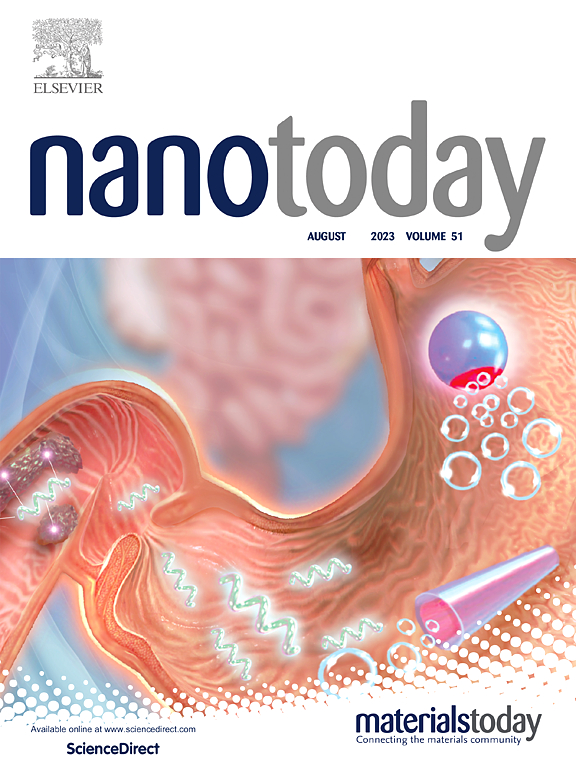MOF nanozyme mediated bacterial metabolic regulation to intervene MRSA antibiotic tolerance for enhanced antimicrobial efficacy
IF 13.2
1区 材料科学
Q1 CHEMISTRY, MULTIDISCIPLINARY
引用次数: 0
Abstract
The rising prevalence of multidrug-resistant pathogens poses a significant threat to human health, with methicillin-resistant Staphylococcus aureus (MRSA) being particularly concerning. Although vancomycin has long been the standard treatment for MRSA, its repeated use can lead to antibiotic tolerance and resistance. The accumulation of bacterial metabolites contributes to this tolerance, suggesting that modulation of bacterial metabolic pathways may provide a novel solution. Herein, we developed Ga/Cu-MOF nanomyze, characterized by a high specific surface area, which could be capable of loading antibiotics and serve as a dual-metal ion reservoir for the sustained release of gallium ions (Ga3+) and copper ions (Cu2+). These ions independently inhibited nitric oxide (NO) production and promoted the decomposition of S-nitrosothiols (RSNO), significantly reducing MRSA's tolerance to vancomycin. Moreover, Ga/Cu-MOF induced programmed cell death in MRSA, specifically targeting ferroptosis and cuproptosis. Antibiotic-loaded nanomyze exhibited robust synergistic antibacterial properties, including the inhibition of biofilm formation and the clearance of intracellular bacteria in macrophages. In preclinical models of skin defect infections in mice and osteomyelitis in rats, Ga/Cu-MOF showed the ability to regulate the host inflammatory response, facilitating faster recovery. Our goal is to reduce bacterial tolerance by modulating metabolic pathways and enhance antibacterial efficacy through bacterial cell death, thereby presenting a potential novel therapeutic strategy for the clinical management of multidrug-resistant bacteria.
MOF纳米酶介导的细菌代谢调节干预MRSA抗生素耐受性以增强抗菌效果
耐多药病原体的日益流行对人类健康构成了重大威胁,其中耐甲氧西林金黄色葡萄球菌(MRSA)尤其令人担忧。虽然万古霉素长期以来一直是治疗MRSA的标准药物,但反复使用万古霉素会导致抗生素耐受和耐药性。细菌代谢物的积累有助于这种耐受性,这表明调节细菌代谢途径可能提供一种新的解决方案。在此,我们开发了Ga/Cu-MOF纳米酶,其特点是具有高比表面积,可以装载抗生素,并作为双金属离子库,用于镓离子(Ga3+)和铜离子(Cu2+)的持续释放。这些离子独立抑制一氧化氮(NO)的产生,促进s -亚硝基硫醇(RSNO)的分解,显著降低MRSA对万古霉素的耐受性。此外,Ga/Cu-MOF诱导MRSA的程序性细胞死亡,特别是针对铁下垂和铜下垂。负载抗生素的纳米酵素表现出强大的协同抗菌特性,包括抑制生物膜的形成和清除巨噬细胞内的细胞内细菌。在小鼠皮肤缺损感染和大鼠骨髓炎的临床前模型中,Ga/Cu-MOF显示出调节宿主炎症反应的能力,促进更快的恢复。我们的目标是通过调节代谢途径降低细菌耐受性,通过细菌细胞死亡提高抗菌效果,从而为临床管理多药耐药细菌提供一种潜在的新治疗策略。
本文章由计算机程序翻译,如有差异,请以英文原文为准。
求助全文
约1分钟内获得全文
求助全文
来源期刊

Nano Today
工程技术-材料科学:综合
CiteScore
21.50
自引率
3.40%
发文量
305
审稿时长
40 days
期刊介绍:
Nano Today is a journal dedicated to publishing influential and innovative work in the field of nanoscience and technology. It covers a wide range of subject areas including biomaterials, materials chemistry, materials science, chemistry, bioengineering, biochemistry, genetics and molecular biology, engineering, and nanotechnology. The journal considers articles that inform readers about the latest research, breakthroughs, and topical issues in these fields. It provides comprehensive coverage through a mixture of peer-reviewed articles, research news, and information on key developments. Nano Today is abstracted and indexed in Science Citation Index, Ei Compendex, Embase, Scopus, and INSPEC.
 求助内容:
求助内容: 应助结果提醒方式:
应助结果提醒方式:


